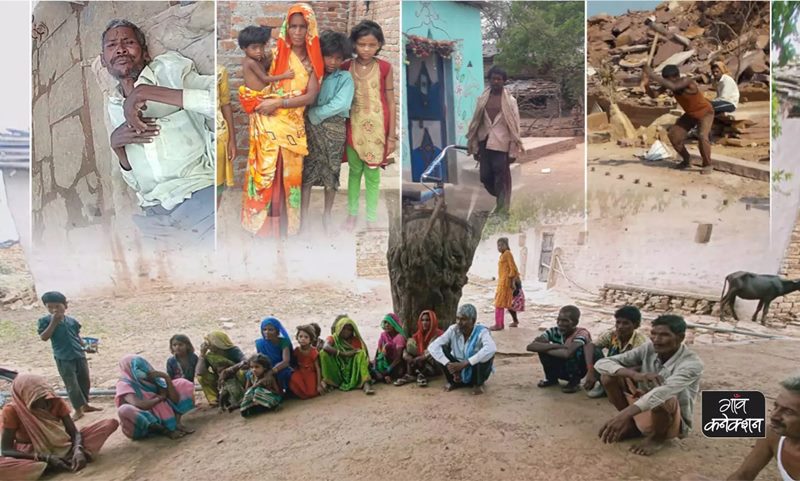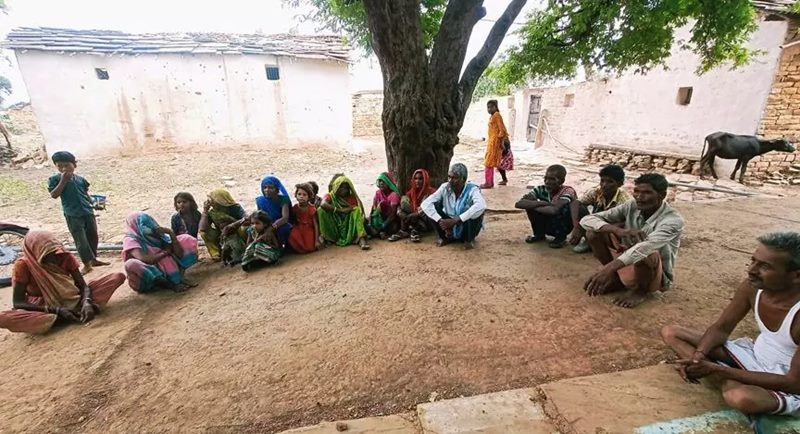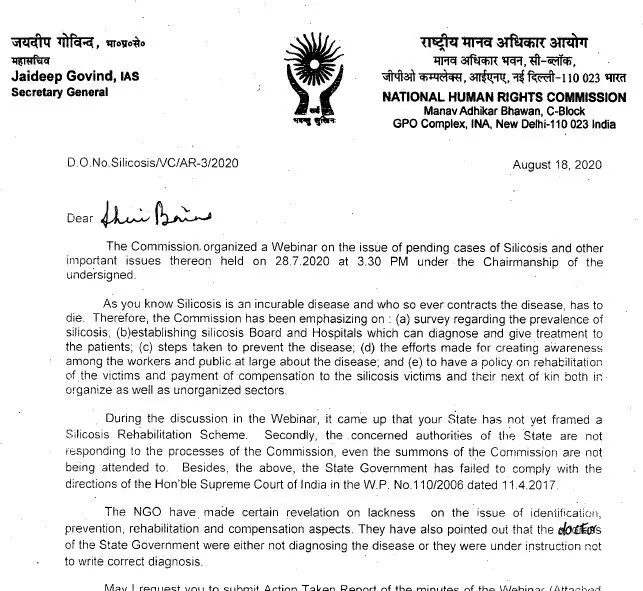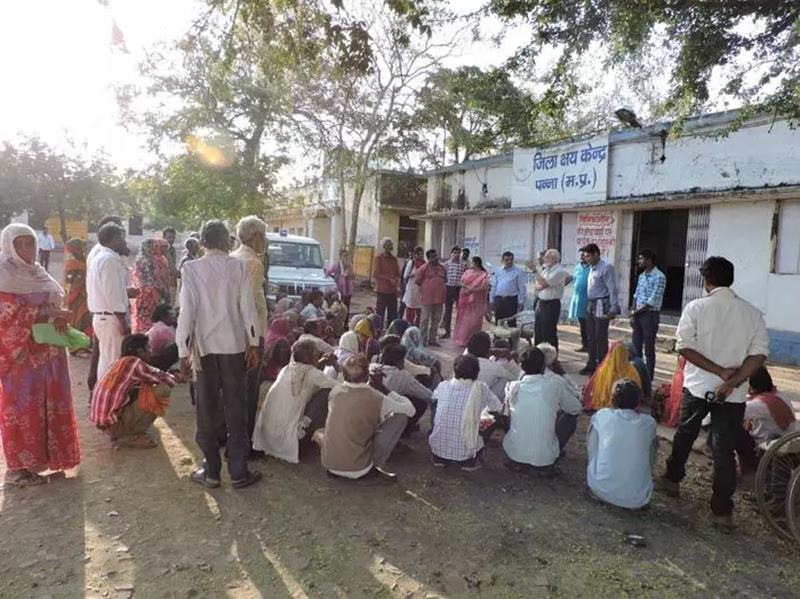Stoned to death: Tribal labourers in Panna’s stone mines continue to die of silicosis
Madhya Pradesh’s Panna district has 106 stone mines that employ poor, under-nourised tribal workers. Many of them contract silicosis and die a slow, painful death. There is a lack of data on silicosis patients, diagnostic facilities are missing and claiming compensation is an uphill battle.


Those afflicted with silicosis continue to suffer, even more so in the time of the COVID19 pandemic. All photos: Arun Singh
Panna, Madhya Pradesh
Sardaiyya Gond is a broken man. He lost his two sons to silicosis, his daughters in law have left home and he lives with a daughter and her three children that he has to provide for. The 65-year-old himself is visibly unwell. Skeletal and constantly short of breath, even a brief conversation leaves him with a paroxysm of coughing.
His older son Dhanuk, who was 30-year-old, died 12 years ago and he lost his younger son, 27-year-old Rajesh, three years ago. According to the medical reports they died of TB, as the village had no diagnostic centre to say otherwise. Sardaiyya lives in Bahul Badaur village in Madhya Pradesh, about 14 kilometers away from the Panna district headquarters.
Both Dhanuk and Rajesh used to work in the local stone mines, daily digging and breaking rocks and inhaling all the mining dust. Sardaiyya has himself worked for 12 years in the stone mines. It is these mines, claims Sardaiyya, that caused silicosis in his family members.
Almost every home in Bahul Badaur village of approximately 800 inhabitants has had someone die of silicosis in the family. The people of the village, most from tribal communities, work at stone mines and they say they have lost track of how many young people have lost their lives.
Silicosis, an occupational disease, affects the lungs. It happens when tiny bits of silica, a common mineral found in many types of rock and soil, is inhaled by the workers. Silica is said to be a carcinogen that can cause lung cancer. Those who work in the mines digging up and breaking stones are vulnerable to this debilitating disease which is considered incurable. Death is almost certain.
Also Read: Powder keg in Karnataka: The Chikkaballapur and Shivamogga gelatin blasts tip of the iceberg
“People work for about ten to fifteen years in the mines, invariably fall ill. They become breathless and can’t move for more than a few steps at a time,” Sardaiyya told Gaon Connection. “There is nothing we can do but wait for death,” he said as he coughed.

Slow death at a young age
“Someone or the other is always dying in this village. In the space of one year, a single family lost three brothers to silicosis,” Pyare Lal, a 60-year-old and Sardaiyya’s neighbour in the village, told Gaon Connection. They were 35-year-old Munna Gond, 25-year-old Balmu Gond and 30-year-old Mulayam Gond.
“Last month, on June 20, Sukhnandi Gond who was 58 years old, also succumbed to silicosis. They all worked in stone mines,” Pyare Lal added, saying he himself suffered from the condition. He is one of the few identified cases of silicosis. He was screened in a camp held at the district hospital in Panna, years ago.

There are 106 stone mines in Panna district, Ravi Patel, district mining officer, told Gaon Connection. “Silicosis is an incurable disease. The only way to prevent it is through awareness and early detection. But that is not available to the workers of the mines,” he added. While government records register not more than 20 odd deaths, there have been so many who have slipped through the nets, Patel said.
Also Read: What is the cost of childhood wasting and severe acute malnutrition in India?
Because of lack of job opportunities, the local tribal population works in these stone mines to earn a living. For many this is the only skill they have and the presence of mines near their habitation makes it a logical choice for them to work there. They break stones, cut and polish them and those are used for construction and many other uses.
After working for a decade or so in these mines, many poor and under-nourished adivasi workers contract silicosis, or tuberculosis, and then die a slow and painful death.
Also Read: Illegal Mining: 46 killed within 7 days in mining-related transport accidents
Lack of data on silicosis patients
Public health activists have been consistently trying to draw government’s attention to the plight of silicosis patients. In 2006, a report/survey titled Destined to Die was written by Amulya Nidhi, a public health activist working on health rights in Madhya Pradesh. He is also a working member of the Jan Swastya Abhiyan.
The 2006 report revealed how in three districts of Madhya Pradesh — Jhabua, Dhar and Alirajpur — there were 1,721 cases of silicosis reported in 105 villages. Of them, 589 people (or 35 per cent) lost their lives. Forty eight per cent of the dead workers were women labourers.
Thereafter, Nidhi also filed a public interest litigation (PIL) on the matter. “In response to my RTI in 2017, the director general of mines said that between 2005 and 2016, in the mines across the country there were only forty three silicosis cases reported,” Nidhi told Gaon Connection.
In April 2017, Nidhi presented an affidavit to the Supreme Court where he stated that in the 29 states and 7 Union Territories in India, 235,445 labourers worked in 44,155 mines in the country, and were at risk of silicosis. However, the government authorities had no clear information or data on these workers, he complained.
“The government has barely any data on the unorganised body of workers who work at the mines, and therefore there is no way they will get any compensation [for death or disease],” Nidhi pointed out.

Data aside, no diagnosis or treatment facilities
According to Pyare Lal of Bahul Badaur village in Panna, there is no facility to diagnose silicosis in Panna, and the doctor usually treats the ailing for TB. “And we keep dying,” he said.
Also Read: Fighting tuberculosis with nutri-gardens
In 2017, the Supreme Court formed a committee under the leadership of Dr Habibullah Sayyed and organised a camp in the district hospital at Panna, on March 25 and 27. Thirty workers in the region were tested and of them 12 were diagnosed with silicosis.

“In 2010, Delhi-based non profit, Environics Trust, got forty three mine workers tested in Panna, of which thirty nine were found to have silicosis,” Ravikanth Pathak, social worker with Panna-based non profit, Prithvi Trust, that works with issues of mine workers and malnutrition, told Gaon Connection.
According to Pathak, there are many villages in Panna where a huge number of inhabitants suffer from silicosis. “More awareness is required, more medical camps are required. Only then will people come forward to get screened for the disease,” Pathak said.
Meanwhile, public health activists have repeatedly pointed out to the state government about the lack of facilities to diagnose and rehabilitate people with silicosis.
Last year, in 2020, the Human Rights Commission reprimanded the Madhya Pradesh government for not coming up with a silicosis rehabilitation scheme as directed by the Supreme Court in 2017.

No rehabilitation policy either
“In 2017, it was in Madhya Pradesh that the matter of rehabilitating and compensation for silicosis came up in the Supreme Court,” informed Nidhi. “After that, in the rest of India, compensations to silicosis patients or their next of kin began to be paid up,” he said.
According to him, some cases of silicosis were identified due to the efforts of civil organisations, the Human Rights Commission and the Supreme Court, but no initiative has been taken by the government to do so.
Meanwhile, those afflicted with silicosis continue to suffer, even more so in the time of the COVID-19 pandemic.
Also Read: ‘It is poison, not water, that comes out of the handpumps’

Compensation woes
“The silicosis patients are worse now. There are no facilities to get screened and for the past year and a half we are just lying at home, suffering,” Dinesh Rai Singh, president of Silicosis Peedit Sangh, in Jhabua, told Gaon Connection. “The few people who do get six hundred rupees a month as rehabilitation pension are also finding it impossible to make ends meet,” he said.
“In Badaur [Bahul Badaur village in Panna] twenty two widows get a pension of six hundred rupees a month,” Roop Singh, the sarpanch of Badaur gram panchayat, told Gaon Connection.
Ravi Patel, district mining officer of Panna, told Gaon Connection: “In 2012-13 four silicosis afflicted workers, on the recommendation of the mining department were paid a compensation of three lakh rupees each. But these are only those who show up in government records. The rest, daily wage labourers, who are not listed in any data, get nothing.
There is an urgent need to collect credible data on silicosis patients across the country and frame a comprehensive rehabilitation policy. These poor workers should not be left to die a slow, painful death while the rocks they break help build the nation.
Read the story in Hindi.

